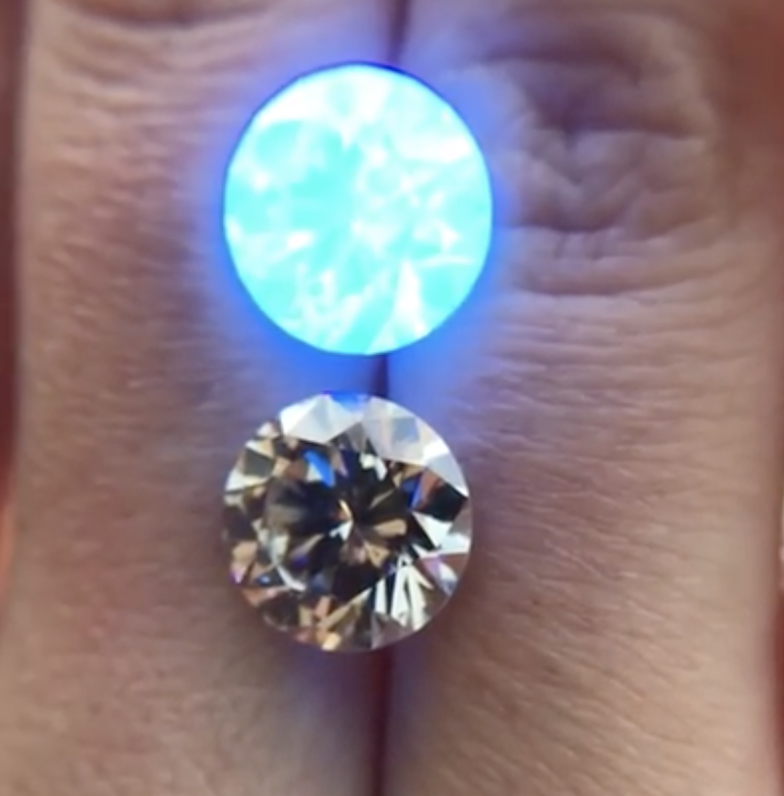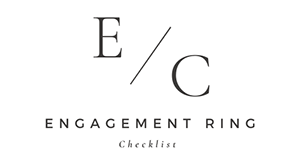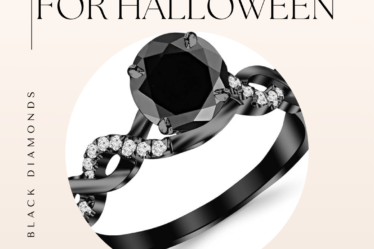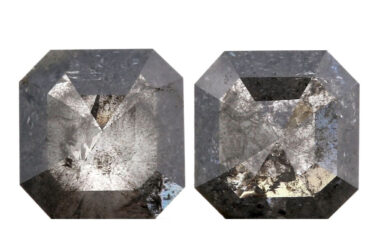
This post from the Engagement Ring Checklist discusses fluorescence in diamonds and whether or not it matters when shopping for a diamond.
Fluorescence in diamonds is a fascinating phenomenon that has captivated scientists, gemologists, and diamond enthusiasts for decades. While it might not seem like the most exciting topic at first glance, the science behind diamond fluorescence is truly fascinating, and can help you better understand this amazing gemstone.
What is Fluorescence in Diamonds? Does Fluorescence Matter in a Diamond?
This post is going to help you decide when and how fluorescence in a diamond matters. Diamond fluorescence refers to the visible light emitted by a diamond when it is exposed to ultraviolet (UV) light. When a diamond is exposed to UV light, it can absorb some of that energy and release it as visible light. This is known as fluorescence.
Fluorescence can occur in many different colors, including blue, green, yellow, orange, pink, and red. The intensity of the fluorescence can also vary, from very weak to very strong.
Why Do Diamonds Fluoresce?
The exact cause of diamond fluorescence is not fully understood, but it is believed to be related to the presence of certain impurities or structural defects in the diamond crystal. These impurities and defects can cause the diamond to absorb and emit light in a specific way, leading to fluorescence.
One of the most common causes of diamond fluorescence is the presence of nitrogen in the diamond crystal. Nitrogen is one of the most common impurities found in diamonds, and it can cause the diamond to fluoresce yellow or orange under UV light.
Other impurities that can cause diamond fluorescence include boron, which can cause blue fluorescence, and hydrogen, which can cause green fluorescence. Structural defects in the diamond crystal, such as dislocations or vacancies, can also cause fluorescence.
How is Diamond Fluorescence Measured?
Diamond fluorescence is typically measured using a UV lamp that emits light at a specific wavelength. The diamond is placed under the UV lamp, and the visible light emitted by the diamond is measured using a spectrometer.
The strength of the fluorescence is measured on a scale from “none” to “very strong,” with intermediate levels of “faint,” “medium,” and “strong.” Diamonds with no fluorescence are often referred to as “non-fluorescent,” while those with strong fluorescence are referred to as “strongly fluorescent.”
It is important to note that diamond fluorescence is not related to the diamond’s color or clarity. A diamond can be perfectly colorless and internally flawless, and still exhibit strong fluorescence. Likewise, a diamond can be heavily included and yellow in color, and exhibit no fluorescence at all.
Does Fluorescence Affect a Diamond’s Beauty or Value?
The impact of diamond fluorescence on a diamond’s beauty and value is a topic of much debate among gemologists and diamond buyers.
Some people believe that diamond fluorescence can enhance a diamond’s appearance, making it appear brighter and more vivid. Others believe that strong fluorescence can detract from a diamond’s beauty, making it appear hazy or milky.
When it comes to value, diamonds with no fluorescence or faint fluorescence are generally considered to be more valuable than those with strong fluorescence. However, there are exceptions to this rule, and the impact of fluorescence on a diamond’s value can vary depending on the specific diamond and market conditions.
Ultimately, the impact of diamond fluorescence on a diamond’s beauty and value is a matter of personal preference. Some people love the look of fluorescent diamonds, while others prefer non-fluorescent diamonds. The best way to determine which type of diamond is right for you is to see them in person and compare their appearance.
Have more questions? Need more help about fluorescence in a diamond? Click on our contact form for more help!



